I am very fond of Vulcania, because it was born from the mind of two of my former fellow citizens. It may be for this reason, but I have always followed the ascendant parable of this role-playing game with particular attention, hoping that it would get a worthy place on the Italian and international rolistic scene.
The funniest thing is that I found out that I had already met in person the two authors behind the Gear Games logo after becoming a supporter of Vulcania‘s Kickstarter project. The quality of the proposal had convinced me even before I knew it came from friendly people.
I had the pleasure of playing a short demo at Modena Play 2019, after which I patiently waited for the right time to open the package of my pledge in a moment when I could dedicate a proper time and review it carefully. The package has remained in my library for several months, but finally the moment has come to lift the lid of the chest and plunge my hands into the treasure!
Such a playful treasure
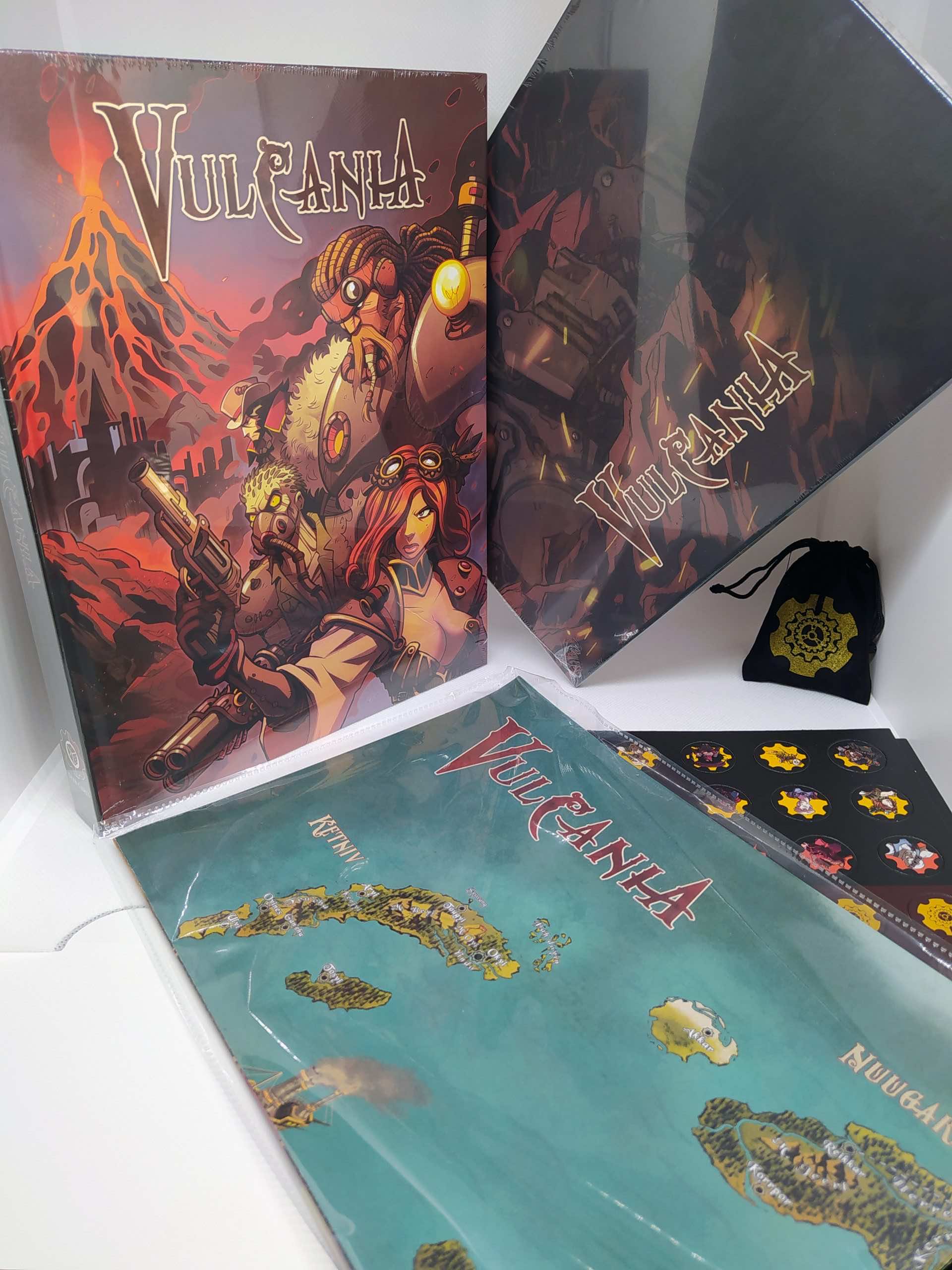
When I looked at Vulcania‘s Kickstarter page for the first time, I immediately appreciated the graphic quality and the argumentative clarity. The steampunk vein permeated every detail. This is why I chose not to limit myself to the manual but also to take stretch goals. Luckily for me, Gear Games collected over € 33,000 and so a lot of material arrived (which is still wrapped as in the image).
My first impression holding the manual and its accessories was the adjective “playful”. We are talking about a roleplaying game, of course, but in this world products and presentations are made in many different ways. There are those who focus on elegance, those on epic, those who want to emphasize the narrative vein or social commitment. Vulcania gives me the idea of a product designed to play, to have fun playing it, to enjoy interacting with friends and objects at the table.
I think, in short, that before being developed by two authors or two game designers, it was made by two players in love with the idea of “playing and having fun”.
Let’s start from the basics
I can’t take it for granted that everyone knows about Vulcania, so I’ll take a step back and go and introduce it to you. It is a fantasy-steampunk roleplaying game full of action, investigation and conspiracies. It is set in a mysterious world, made up of six volcanic archipelagos that offer different and colorful landscapes, cultures and possibilities. The system is completely based on the d12 and the token support (which we will discuss later).
Materials and components of Vulcania
Let’s go back talking and evaluating more carefully everything that has arrived to me. We can start from the manual. Hard cover, over 450 color pages, quality paper and binding. A tome of a certain weight. We will analyze its content later.
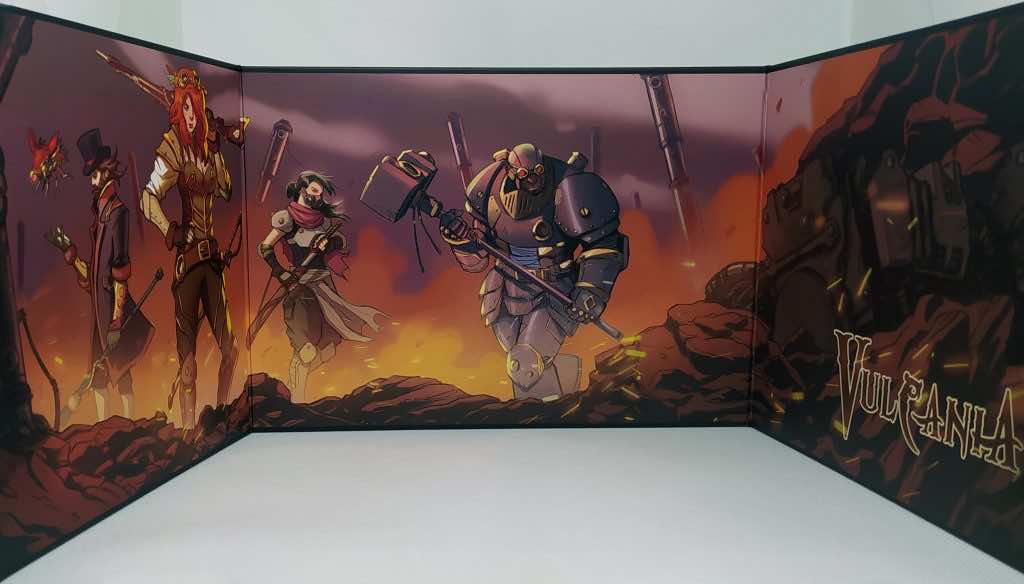
There is also the narrator screen, in the classic format of recent use, the equivalent of 3 A4 sheets arranged horizontally. I immediately noticed that there is not much information on the screen. This means ample space and excellent readability. An entire panel dedicated to the Maiming a Character Table, for the greatest joy of the most sadistic masters. On the other hand, essential indications for this setting: costs and times of travel by sky and by sea between the different archipelagos. Little else, which gives me hope not for shortcomings on the screen but for a game that does not require constant use of the rules.

Then there are the maps. Four tactical maps on two A3 thick sheets on both sides plus a poster format sheet with on one side the map of the entire world of Vulcania and on the other the tactical map of a airship. High quality, in the material as in the colors and in the choice of the situations depicted. The world map is very useful, being a game that leads to travel a lot. Among other things, maps arrived in a transparent plastic cover that contains them all together and facilitates their transport.
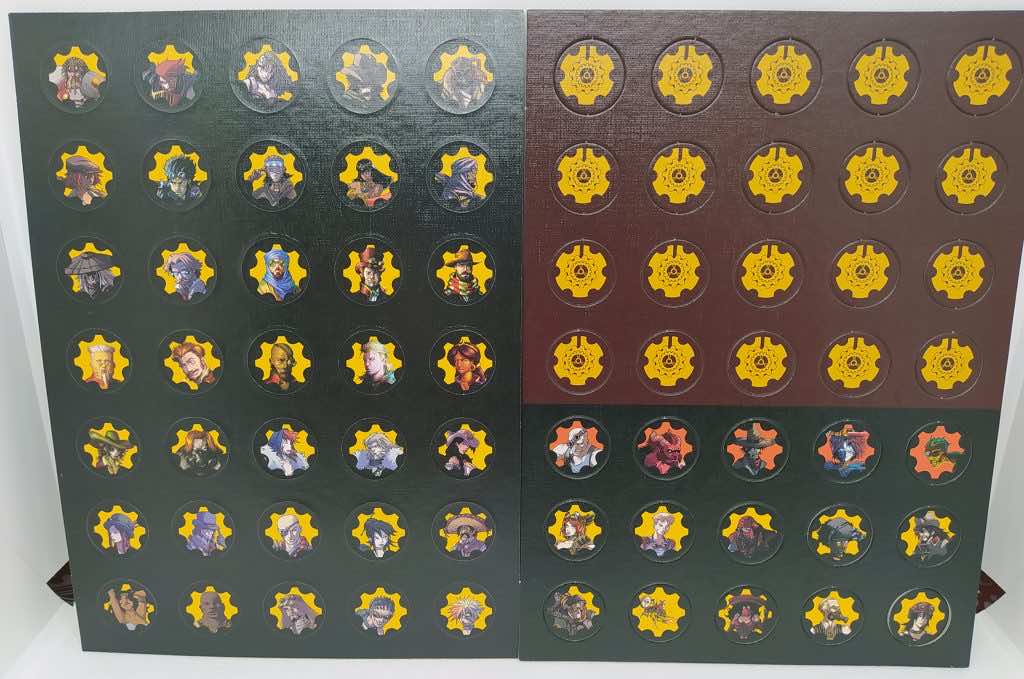
The tokens and the dice complete the set. There are fifty tokens depicting characters, on one side with a red background and on the other with a yellow background (useful for signaling the status), plus twenty tokens representing the Vulcania logo, a series of concentric gears. They are called Gears of Fate and we will see their use when we talk about the system. The dice, six 12-sided dice with colors that reflect the game’s title and logo, were also created to support the mechanics. In addition to the skull in place of the number 1, the numbers 11 and 12 are framed by a gear, to remember the possible development of further moves with those results.

Needless to say, I am very satisfied with the materials and accessories that have arrived to me. They continue to communicate that “playful” feeling I was talking about and they really make me want to put on the world map, create a character and accompany him in his story. So first I want to know the places!
Vulcania islenations
After a catastrophe thousands of years ago, the populations of the various archipelagos of Vulcania have evolved without contacts with each other, creating very heterogeneous cultures. One day, the brilliant Eriko Fermy (get ready, there are quotes and word games on every corner) invented the first Vulcanus battery, allowing people to travel and get to know each other. As unfortunately often happens in the history of men, getting to know each other after a while has become a clash and thus began a war that ended in a fragile peace 13 years before the year zero of the game.
It is therefore time to go and see the pawns on the world chessboard, the six Islenations of Vulcania.
Abrabazem

Abrabazem, once a world power, paid the highest price in the war. His eternal rival, Mostucaal, dropped the Z Device (probably in addition to being fellow citizens me and the authors watched the same cartoons) in the Abrabaz volcano, generating a real catastrophe. The Islenation still pays a heavy price. There are no more cities, no more economy, no more government. The few remaining inhabitants are intoxicated and subject to strange mutations.
Itteghasp

Just because the name of this isonation is the anagram of spaghetti, a cool way to start talking about it. (Do you remember the concept of “playful”?). This archipelago has three volcanoes. During the war Itteghasp was neutral and is now a thriving place, a global beacon of technology, crafts and fashion. As well as the seat of the Monopolies, international private organizations possessing secret knowledge and technologies.
Balastoc

Ruled for centuries by the ultra-conservative clergy of the cult of Isairnes, Balastoc is an overpopulated land and technologically strongly set back. The rise to power of the very young Red Pope Fathin Er Kaddhuri brought a wave of innovation throughout the country, with the possibility of using modern technologies considered heretical so far and the domineering entry of Monopolies into the new market.
Ketniv

The island is an agglomeration of rugged mountains and steep valleys furrowed by impetuous rivers. It has always been ruled by the Emperor (Kobyi dynasty, a thought for the Black Mamba) for hundreds of years who, thanks to the bureaucrats, controls the duties, marriages and in practice the lives of the entire population. Aviation is the flagship of the economy and the Garghantua project was carried out here, which brought three flying cities to fly over the skies of Vulcania. And they still fly over it.
Mostucaal
These are the bastards of the Z Device. But they too paid the price. Powerful and expansionists, the rulers have pushed the accelerator ignoring the well-being of the people, practically blowing up a bomb in their home too. Now most of the country is in chaos after the end of a bloody civil war.
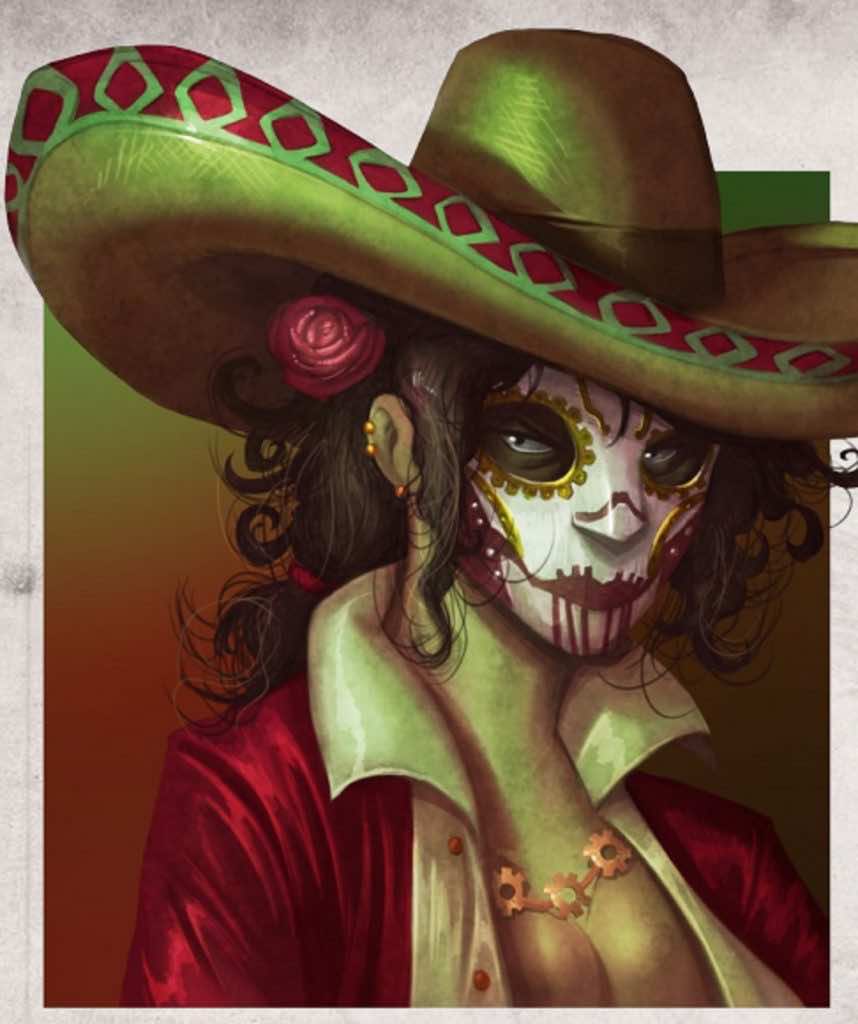
Nuugard
The Nuugard is a harsh and icy territory, inhabited by a proud and outspoken people, respectful of nature, which has also maintained a prudent and animal-inspired approach in its developing of technology. The government is formed by the Council of Counts. Each Count controls his own clan and territory in total autonomy.

This is a very short overview of the world. In fact, the manual has 81 pages dedicated to the setting full of content and full of ideas. Each Islenation is analyzed in detail. Places and especially power groups are provided, from the Demons of Abrabazem to the Sisters of the Flame of Balastoc. Society descriptions wink at many well-known realities, from the Japanese to the Mexicans, providing hooks that also allow beginners to have a starting point for interpreting.

The setting ends with the flying cities of Garghantua, organizations such as Monopolies (of Engineers, of Alchemists …), banks and much more. Ideas, glimpses, windows open on stories and possibilities. I continue to feel the desire to play in these pages and I must say that it is really contagious. Now that we know where we can go, let’s see who you can be!
It’s time for characters (pt. 1): Origins and Past Experiences!

Vulcania‘s characters are all human and the differences between them are brought from the place of origin, of which we have just spoken. The choice of the Past Experiences, what the character was before the adventure began, lays the foundation for the creation. By choosing your Past Experiences you get information and indications for the character’s psychology, his equipment, his preferences in combat and, the bonuses to the Skills and the Arts. There are many generic backgrounds, common to many games, such as acrobat, the medic, the mercenary, the rifleman, the engineer, the militia, the psyonicist, the wanderer, the track hound. Then there are other intriguing backstories, interesting in the development of your alter ego, such as the smuggler, the informator, the cutthroat. And finally there are enough unique Past Experiences, related to the setting and very stimulating: the biopsist, the entropist, the markonist.
The latter three deserve a brief description. Biopsists are a bit of an alchemist and a bit of a biologist, faithful to the secrets of the Monopoly of Alchemists and curious to discover and experiment with dark and unstable concoctions prepared on more or less suitable guinea pigs. What biopsists do silently in their laboratories entropists do it with dangerous substances and reagents that study, mix, test and, more often than not, detonate. With their great satisfaction. Markonists are instead able to use remote devices through the mind. In particular a personal drone, a small mechanical creature fully customizable through grafts of the most varied functions.
The gallery is completed by the regional Past Experiences. The desperados of the Mostucaal, the fencers of Itteghasp, the Ketniv monks, the warrior priestesses of Balastoc, the survivors of Abrabazem or the Valkyrs, the warrior elite of Nuugard.
It’s time for characters (pt. 2): Arts, Attributes and Skills!
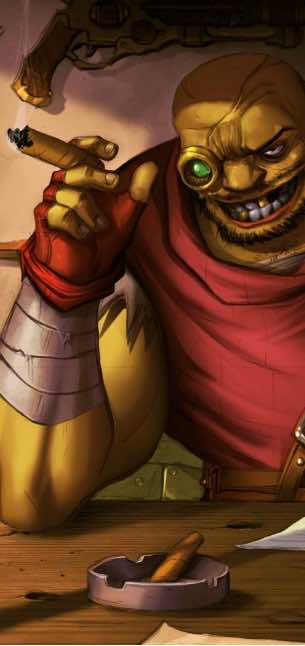
The Arts represent the areas of specialization of the characters, acquired at the time of creation with the choice of the Past Experiences and obtainable in the future by paying to obtain their advantages. They confer specific skills, knowledge, or competences, possibilities to use the Skills in an advanced way. There are Professional Arts, linked to particular spheres of knowledge and Combat Arts, which allow you to make special moves and maneuvers.
There are 11 Professional Arts and 11 Combat Arts, each with more than one specialization. Impossible to give a description of everything but there is a lot of variety and imagination. The Omegha, Phi and Psi schools of Markonism, the School of Crime, the Circus School, to name a few Professional Arts. Or the Guascon school, the Kravmaga school, the Landsknecht school are some examples of those of Combat.
Speaking from a more mechanical point of view, a character is defined by four Attributes (Stamina, Dexterity, Mind and Magnetism) in which six points are allocated plus the bonus of the origin. Another important aspect is represented by the Skills, given by the Past Experiences and by six other points distributed by the player. There are four Skills for each Attribute, for a total of sixteen. After this phase, the secondary statistics, Dodge, Evade, Initiative, Movement and Wounds are calculated.

The choice of personality gives a final mechanical touch with situational bonuses, a couple for each choice. Furthermore, according to the personality, the character can choose a vice; when he has time in play to indulge in this vice, he will get a Gear of Fate.
After all it is a varied and colorful choice, full of ideas and inspirations. Similar to everything I have read so far about Vulcania, it is nothing incredibly new or original, even if there are really interesting things here and there. There are many classic elements, of multiple genres, carefully mixed, with the ability to give important and stimulating details and which ultimately provide an excellent base for playing.
Praise the d12s, the Vulcania system!

Vulcania is really simple under this point of view. D12 + capacity value against a difficulty class decided by the narrator, with the usual variations of extended, opposite tests and so on. Things get interesting when you get an 11 or a 12. An Opportunity opens and the player will propose a favorable condition for the character. The narrator will decide whether to accept it or, if considered exaggerated, will give a generic +1 to the next test. Or the narrator will invent something for those players in analysis paralysis. Reverse speech for when a 1 comes out, where everything will be in the sadistic hands of the narrator.
I like that the player is given the opportunity to be the protagonist of the success of his character. Considering that this happens statistically once every 6 rolls, unlike the Catastrophic Failure events that occur one every 12 rolls, we understand the spirit and the propulsion of the game to risk and obtain successes.

In combat, the Opportunities / Failures formula is enriched and enriches the fight itself. Because Opportunities can also be activated in the event of defensive maneuvers or initiative shots, continuing to make players protagonists of dynamic and engaging battles. In particular there are the Basic Opportunities, common to all, the Art Opportunities, special abilities related to one’s own Combat Art and the Weapon Opportunities, related to what is being held.
For the rest, Vulcania system in combat remains more or less in the canon of tactical combat, in a balanced and reliable way. Here and there some goodies remain, the constant confirmation that the desire to play was really the driving force behind the creation of this product. In particular the aforementioned Maiming a Character Table, the choice of the visible signs obtained when a character escaped death by being revived. And that table is quite ruthless: hooks instead of hands and sheared noses are not so rare.
A zoom on weapons

Vulcania‘s weapons deserve a separate chapter. As we embrace both fantasy and steampunk, the selection is truly colorful, with many stylistic possibilities. The weapons have an increase in damage based on the type and on the roll, wonderfully combined with colors, which immediately render the idea. Among the possible values from 1 to 12 of the dice roll there may be green areas (2 damage), yellow areas (3 damage) and red areas (4 damage). It will be so intuitive for the player to choose and remember what his weapon does.
A mention of the rest of the equipment: which among gizmos, remote devices, special kits, poisons and, I quote verbatim, remedies of the Old Gretchen, will not fail to attract and amaze. Without forgetting the transports, from the steamcycle to the airships.
Gears of Fate: what goes around comes around!

Another peculiarity of Vulcania are the Gears of Fate. During each game session, each player has three Gears of Fate token available to try to corrupt fate and thus obtain the possibility to retry a failed test, remove a negative condition or benefit from an opportunity just as if he has obtained an 11 or a 12 with the die roll.
We must be very careful to trick fate, because it could ask for the bill with interest! When a Gear of Fate is spent, it is delivered to the narrator who can in turn dispose of it to cancel an Opportunity used by a player, inflict an unexpected event on a failure or reward a player who has performed a particularly heroic action.
Again there are no particular new ideas compared to many other games, but the nuances are interesting. Passing the token to the narrator increases the dangerousness of the situation, making every expense of a Gear something to weigh. The ability to activate an Opportunity in combat is very nice, particularly useful when you need the right roll at the right time and the dice do not agree.
But what’s still in the manual of Vulcania?
Gentlemen, we are talking about over 450 color pages. There is really a lot of stuff! We are still missing three things. The first is the section for the narrator, also full of notions, suggestions and possibilities. From the weather to the examples of traps, almost nothing has been left out. The authors had many things to say! In other rulebooks occasionally we happen to find visibly fast chapters, either because of the lack of space or because of the layout given in the manual. In this case the feeling is the opposite, the number of pages it is not a problem, the authors could say all the things as they wanted.

Then we have a section dedicated to adversaris, with clear cards and a good variety of enemies, cleverly divided between creatures, villains and antagonists, to help build fights and focus players on targets that are worth facing and remembering. The provided list of encounters is also useful, with narrative and composition ideas for the group of opponents.
Last but not least an introductory adventure. Well done, precise in the background and careful to immediately perceive the uniqueness of the world of Vulcania. It has 34 dedicated pages, a significant space that makes it clear that it is not three encounters in a flat story but something much deeper.
Art and Layout

Everything is very cool. I abounded in pictures in this review to give you an idea of the quality and style. I like them very much and I find them very spot-on. The map is clear, the weapons and creatures entries are easy to consult and immediate. The character sheet comes in three versions. Base, alternative and foldable. Yes, there is the foldable version along three lines so that it can stand up and be turned over according to the situation. What do you say? Very nice and very playful? Really!
The only negative note that I found, at least in the Italian language PDF version, is the high number of typos and small errors. I have rarely found so many inaccuracies in such a short time. Maybe I had bad luck, maybe in the printed version they were corrected. But for the level of product care it is very unconvenient.
But do they pay you to promote Vulcania?

Unfortunately not. Indeed, as No Dice Unrolled was not yet online I had to pay up to the last euro to have Vulcania in my hands. I am a player who turns on easily for the news and this certainly affects the enthusiastic tones of many of my evaluations. But my appreciation for Vulcania is sincere and genuine.
Actually, I didn’t think that I’d have liked it so much. The materials are excellent, as the whole graphic compartment. The setting is particular, detailed, not trivial, full of quotes and kaleidoscopic. Then it’s all about tastes, but it is well done. The system is not complex, it has some very interesting ideas, in particular it focuses a lot on the involvement of the players. The characters really have many possibilities, they have their own depth and make you want to play them. And then, as I repeated until the nausea, it is really impregnated by the love for roleplaying and the desire to play. And that’s what made me fall in love. I’m sorry I haven’t had a chance to try it satisfactorily yet, but I certainly won’t miss it.
If Vulcania has flaws, it hides them really well!


Trackbacks/Pingbacks